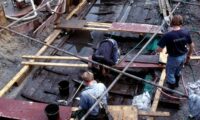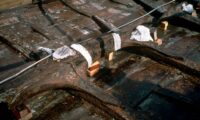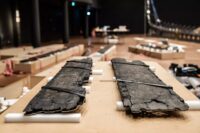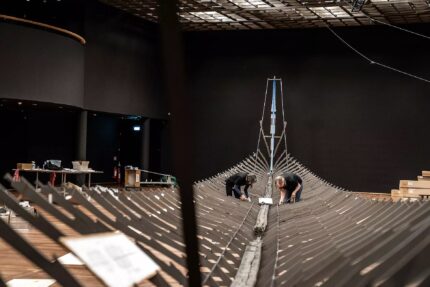The world’s longest Viking longship, the Roskilde 6, is being installed for a new exhibition at the National Museum in Copenhagen that starts June 25th. The Roskilde 6 has been traveling for years, touring Germany, England, Canada and the US. Last Friday it arrived packed in 27 boxes and curators have been piecing it back together.
At 37.4 meters (123 feet) long, twice the length of Columbus’ flagship La Santa Maria, it is the longest Viking ship ever discovered. The keel alone is 32 meters (105 feet) long, the longest keel ever found on a Viking ship. It was 13 feet wide at the widest point and had a shallow draught of just 33 inches.
 Roskilde 6 was discovered in February 1997 by workers dredging the Roskilde harbor before construction of an extension to the Viking Ship Museum. Nine shipwrecks from the late Viking and early Medieval periods were discovered at the site. Roskilde 6 had been dragged into the shallows and partially dismantled along with a half dozen ships to serve as defensive barriers in the harbor of Roskilde Fjord.
Roskilde 6 was discovered in February 1997 by workers dredging the Roskilde harbor before construction of an extension to the Viking Ship Museum. Nine shipwrecks from the late Viking and early Medieval periods were discovered at the site. Roskilde 6 had been dragged into the shallows and partially dismantled along with a half dozen ships to serve as defensive barriers in the harbor of Roskilde Fjord.
Today about 20-25% of the longship survives, the timbers preserved for centuries in the waterlogged mud of the fjord’s shoreline. Dendrochronological analysis indicates the ship was built after 1025, and the type of oak points to it having been built not in Denmark but in Norway, near Oslo. It was in active use for at least 15 years, as there is evidence of repairs using timber felled from the Baltic area in 1039.
 Roskilde 6 was an ocean-going warship, not a ceremonial one like many of the ship burials which were built solely for funerary purposes, and the high quality of its materials and workmanship points to it having been part of the royal fleet. Its large size required adaptations to ensure it would be flexible enough to navigate the choppy water. The keel was actually made of three parts connected by long scarves. The planks of its hull were barely more than an inch thick, which made it comparatively light in weight for its length. The floor planks were riveted together and half-frames placed on top of them. The keelson, of which a 10-foot section has survived, was fastened to the hull with meticulously carved horizontal double knees.
Roskilde 6 was an ocean-going warship, not a ceremonial one like many of the ship burials which were built solely for funerary purposes, and the high quality of its materials and workmanship points to it having been part of the royal fleet. Its large size required adaptations to ensure it would be flexible enough to navigate the choppy water. The keel was actually made of three parts connected by long scarves. The planks of its hull were barely more than an inch thick, which made it comparatively light in weight for its length. The floor planks were riveted together and half-frames placed on top of them. The keelson, of which a 10-foot section has survived, was fastened to the hull with meticulously carved horizontal double knees.
 The ribs over the hull at regular interviews correspond to where the thwarts (the rowing benches the oarsmen sat on) were placed, making it possible to calculate the full length of the warship and the size of its crew. Early Viking ships were small, fitting crews of 40 men. This one had a crew of 100, 80 rowers, two men per oar.
The ribs over the hull at regular interviews correspond to where the thwarts (the rowing benches the oarsmen sat on) were placed, making it possible to calculate the full length of the warship and the size of its crew. Early Viking ships were small, fitting crews of 40 men. This one had a crew of 100, 80 rowers, two men per oar.
The preserved timbers have been mounted on a steel skeleton to give visitors a realistic view of its impression dimensions when it was intact.

Totally amazing!
I wonder if they had to extend their museum again, or did they think that enough (exhibits) was enough 😉
Hi hi :giggle: –Yeah, maybe they should indeed do another extension and ship, therefore, even some more boats.
The ‘Römisch-Germanisches Zentralmuseum’ (RGZM), Leibniz Research Institute for Archaeology, had info on Roskilde number 6 and the Roskilde harbor before the construction of that extension.
Do mind, however, that you need to put here “www2.” in front of “rgzm”, otherwise –i.e. with “www1” only– it just wont unearth anything, cf.:
rgzm.de/navis/ships/ship092/Ship092.htm
particularly:
rgzm.de/Navis/Ships/Ship092/Image/092F001.jpg
rgzm.de/Navis/Ships/Ship092/Image/092F029.jpg
rgzm.de/Navis/Ships/Ship092/Image/092F032.jpg
They should build that ship. So they can proof what they say that its a safe ocean going ship
Particularly “Ribs at regular interviews” will probably get you anywhere :p
From the ‘Gesta Hammaburgensis ecclesiae pontificum’, written before 1085AD) on obviously North America and the king of the Danes in Bk.IV.39:
———
“The round globe makes the course of the accessing sun bring day, and else the recessing sun leave night. At summer solstice, it prolongates the days and shortens the nights to those that are in the North; and while it descends to winter solstice, it brings the corresponding to those in the South. Unaware of that, the pagans call that land holy and happy, because it presents those miracles to the mortals. This has now been confirmed by the king of the Danes and many others happening there as it does in Sweden and in Norway and the rest of the islands over there.
Also, he talks about a newly found island among the many in that ocean, which is referred to as ‘Winland’, because grapevine grows there on its own, bearing the best vines. That over there the abundant crops are not sown, we get to know not only from fanciful opinion but from the true account of the Danes. Beyond that island, he says, habitable land is not found in that ocean, instead all territories beyond are full of intolerable ice and immense fog.
On this, Martianus[?] comments as follows: One day of sailing beyond Thule, he says, the sea is frozen. Harald, the most enterprising leader of the Normans, recently tried that. He who searched with his ships the northern latitude at last backed down safely from the nebulous harsh extreme end of the world, hardly avoiding tha vast abyss of Hell by reversing his track…”
[LATIN SPEAKERS, WALK THE ‘OUSE!]
“…Nam propter rotunditatem orbis terrarum necesse est, ut solis circuitus accedens alibi diem exhibeat, alibi recedens noctem relinquat. Qui dum ascenderit ad aestivale solsticium, his qui in borea sunt dies prolongat noctesque adbreviat; descendens autem ad hiemale solsticium, simili ratione facit australibus. Hoc ignorantes pagani, terram illam vocant sanctam et beatam, quae tale miraculum praestet mortalibus. Itaque rex Danorum cum multis aliis contestatus est hoc ibi contingere, sicut in Suedia et in Norvegia et in ceteris quae ibi sunt insulis.
Praeterea unam adhuc insulam recitavit a multis in eo repertam oceano, quae dicitur ‘Winland’, eo quid ibi vites sponte nascantur, vinum optimum ferentes. Nam et fruges ibi non seminatas habundare, non fabulosa opinione, sed certa comperimus relatione Danorum. Post quam insulam, ait, terra non invenitur habitabilis in illo oceano, sed omnia, quae ultra sunt, glacie intolerabili ac caligine immensa plena sunt.
Cujus rei Martianus ita meminit: Ultra Thulen, inquiens, navigatione unius diei mare concretum est. Temptavit hoc nuper experientissimus Nordmannorum princeps Haraldus. Qui latitudinem septentrionalis oceani perscrutatus navibus tandem caligantibus ante ora deficientis mundi finibus, inmane baratrum abyssi retroactis vestigiis vix salvus evasit…”
———
:hattip:
In Bergen, wiki.uib.no/medieval/index.php/Adam_Bremensis#Sources_2 annotates:
“Besides this, Adam gathered information from personal interviews. He introduces King Sven Estridsen of Denmark as the main witness for his knowledge of the Nordic world and its history. Sven serves as a main link between Adam’s own world and the regions beyond Denmark, called alter mundus: Sweden, Norway, Iceland, and several islands up to the edge of the world (see SCIOR 2002). Adam interviewed Archbishop Adalbert and other bishops, priests and missionaries sent out to the North, thus referring at last to some oral traditions related to Bremen. He must also have talked to merchants and sailors returning from the Baltic Sea, who made Bremen a place of exchange of information about the North. That is why Adam’s knowledge exceeds by far that found in other written sources. A famous example is the mention of Winland (ch. 39), a region later identified as Newfoundland.”